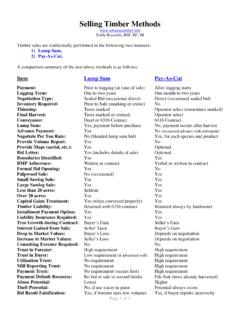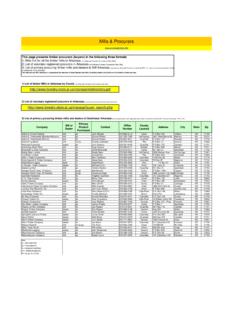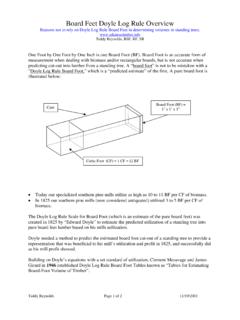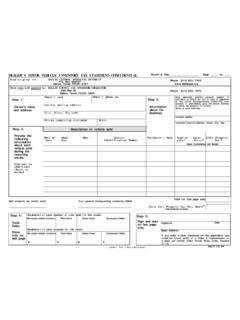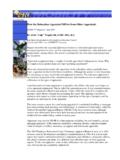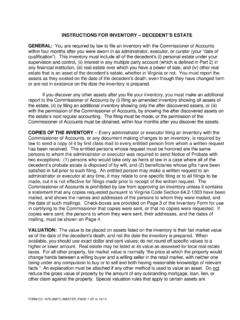Transcription of Inventory Methods
1 Page 1 of 5 Inventory Methods Teddy Reynolds, BSF, RF, SR - Reynolds Forestry Consulting RFC Inc. Paul Doruska, , RF, CF - UAM School of Forest Resources There are three primary Inventory Methods practiced in our southeast 13-pine belt states (Texas to Virginia) which are overviewed as follows: 1) Plot Cruise (fixed plots) 2) Prism Cruise (variable plots) 3) 100% Tree-Count (Marking) The three dominant practiced Methods are compared below: Comparison 100% Tree-Count Plot Cruise Prism Cruise Fixed Plots Installed No Yes No Variable Plots Installed No No Yes All Trees Counted Yes No No Sampling Error No Yes Yes Human Error Yes Yes Yes Stand Variation Influences Accuracy No Yes Yes Percent Error for less than 120 plots 0% Error 10% to 50% 10% to 50% Percent Error for more than 120 plots 0% Error 2% to 10% 5% to 15% (dbh dependent) Intensity Higher Lower Varies with dbh Accuracy Highest Lower Lower (dbh dependent)
2 Management Use for Planning No Yes Yes Estate Planning Use for Taxes No Yes Yes Inventory Thinning Use for Selling Yes No No Inventory Final Harvest Use for Selling High Use Medium Use Low Use Procurement Use Seldom High use Low Use Ease of Use in Field Simple Simple Simple Time Involved High Medium Low Calculation Complexity Simple Medium Complex Seasoned Experience Improves accuracy Yes Yes Yes An overview of each method follows: 1) Plot Cruise (fixed plots): Plot cruises are popular for procurement, appraisals and estate planning. A cruise is conducted to estimate the number of trees in a forest by species, diameter, height, form class and grade. All fixed plot cruises have statistical sampling error which is important to know and understand before relying on the data. A plot cruise simply consists of counting and classifying all trees in a series of circular sample plots.
3 Circular plots are usually 1/10-acre in size ( feet radius). The plots are evenly spaced throughout the stand to provide an equal sampling of all forest types across all topographic changes. The plot information is then extrapolated to one acre and then multiplied by the total acres as illustrate in the two examples below: One plot on 1-acre: Plot size 1/10-acre Plot radius (feet) Average trees/plot 8 Factor to 1-acre 10 Number of trees/acre 8 x 10 = 80 40 plots on 60-acres: Plot size 1/10-acre Plot radius (feet) Cumulative trees in all fixed plots 320 Total number of plots 40 Page 2 of 5 Average trees/plot 320/40 = 8 Factor to 1-acre 10 Number of trees/acre 8 x 10 = 80 Number of acres 60 Total trees on 60-acres 60 x 80 = 4,800 In addition to the tree count.
4 The following information is ordinarily collected in the plots: a. Pine Sawtimber. b. Pine Pulpwood. c. Red Oak Sawtimber. d. White Oak Sawtimber. e. Miscellaneous Pulpwood. f. Hardwood Pulpwood. g. Diameter at breast height ( feet above the ground; dbh). h. Merchantable height in 16 feet logs (to set top end diameter or where limbs excessive). i. Form Class (degree of taper in a tree). j. Grade (quality of the timber based on straightness, soundness and knots). An example of a volume report produced from cruise field data is as follows: Refer to insert #1: Volume Report Determining the appropriate number of plots to install in a cruise is very important. Unfortunately, few landowners, consultants, or procurers appropriately determine the right number of plots to install. We tend to install too many plots creating unnecessary costs or do not install enough plots causing unnecessary risk.
5 The adequate numbers of plots to install in a cruise are based on three variables: 1) Desired Percent Error (selected by landowner or forester; preferably 5% - 10%). 2) Set Probability (selected by landowner or forester; preferably 90%). 3) Tree variation in each forest (tree uniformity or lack of uniformity in each stand). As illustrated below, the increased number of plots installed in a cruise desirably lowers percent error. While on the other-hand, increased tree variation (lack of tree uniformity, for example each plot has a large difference in the number of trees counted) increases percent error thereby requiring additional plots to counter the variation s negative impact. Greater tree variation increases the need for more plots, while uniform stands require fewer plots to achieve the same or lower percent errors. Tree variation is simply measured by the varying number of trees occurring in adjacent plots.
6 If three plots respectively had 2 trees, 9 trees, and 5 trees; then this stand has higher variation and will need 75-plots to achieve a 10% error (based on 90% probability). If three plots respectively had 7 trees, 5 trees and 3 trees; then this stand has a lower variance and will require only 28-plots to achieve a 10% error (based on 90% probability). Over 50% of landowners and professionals mistakenly interchange cruise percent for percent error , which are crucially two different things (illustrated below). Cruise percent is simply the amount of surface acres sampled by the cumulative plots and is not the same as percent error . As illustrated in the table below, a cruise percent of 10% with 40 plots produced a 14% percent error and a cruise percent of 20% with 80 plots produced a 10% percent error (40 1/10th-acre plots on 40-acres = 4 acres sampled on 40 acres = 10% sampled surface area = cruise percent).
7 Unlike cruise percent, percent error is based on tree variation, number of plots, and selected probability. Refer to insert #2: Percent Error Table Another important factor to remember is the number of acres involved in a cruise does not influence percent error. Percent error is determined by the number of installed plots combined with stand variation (acres are not included). For example, if two stands are identical in variation and only differ in number of acres and plot ratio to acres, which of the following cruises is more accurate: Stand #1 1-plot per 1-acre 40 plots 40 acres Tree variation same as #2 below Stand #2 1-plot per 2-acres 50 plots 100 acres Tree variation same as #1 above Page 3 of 5 Over the past 10-years in presenting this question, less than 5% of landowners and practicing professionals answer correctly.
8 1-plot per 1-acre appears more intensive, while in reality it is not because it only produced 40 plots, while the 1-plot per 2-acres produces 50 plots achieving a higher intensity with greater representation and resultantly less percent error. A cruise or appraisal without a stated percent error is as valuable as one shoe. This mathematical phenomenon has yielded many procurers and landowners richer or poorer. Consequently, the best margins for financial gain based on percent error in procurement are experienced in sales less than 120 acres, which lack uniformity and are advertised by a cruise. There are two solutions, increase the number of plots until an acceptable percent error is achieved and/or 100% tree-count (mark) all stands less than 120 acres and greater if adequate dependable staff are available. Human error is an additional factor that plays an important role in the accuracy of inventories.
9 I have witnessed and personally experienced 100% tree-count (marked) sales and cruise sales where the purchaser reaped considerable over-cuts. Consistent over-cuts exceeding the statistical percent error can often be traced to: 1) Inexperienced markers and cruisers. A college degree does not rank as experience. Also, years in the woods does not rank as experience. Only a marker or cruiser s actual cut-out report from the mill determines their personal accuracy (the question is do they have 10-years experience, or 1-year experience 10-times). 2) Improper cruise layouts. Cruises should cross all drains and topographic elevation changes to ensure maximum cross-section of all forest types and sizes. 3) Forestry consultants sub-contracting contract cruises to third parties. For example: A landowner or company contracts a cruise to an established consultant who contracts the field work to a third party; the original consultant will prepare the reports with their letterhead, but the field data collection was performed by an unassociated third party for a lesser price.
10 There are reasons why third party contractors are in positions to accept lower rates for their work (often they are between jobs, attempting to start companies, moonlighting, dabbling, part-time, or struggling to develop a direct clientele base). The field cruiser is as important as your attorney, managing forester and accountant. You waited 25 50 years for the investment return, and the field data collection (cruise) determines the accuracy of all following reports, decisions and returns. 4) Low wages for field foresters and technicians resulting in low effort. 5) Hot, tired, chigger-infested, hungry markers and cruisers late in the day. 6) Utilizing summer student interns. 7) Poor supervision and accountability. 8) Too much ocular estimation (ocular estimations should be periodically checked with instruments). 9) Utilizing prism cruises in brushy stands (prisms can only accurately be used in clear, open stands).
